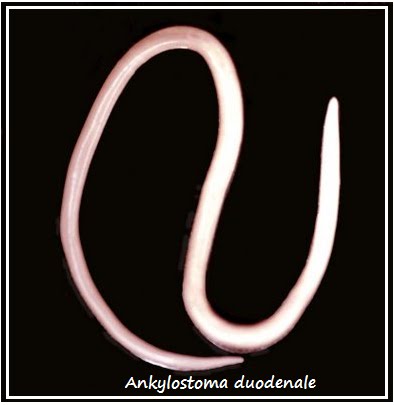Laporan Uji Aktivitas Anti Cacing
Asian tiger shrimp ( Penaeus monodon) shell is an industrial waste which becomes one of the sources of carotenoids in the form of astaxanthin (3.3’-dihydroxy-β, β′-carotene-4.4′-dione) which has a very potential biological activity because it can work on target molecules. Astaxanthin in Asian tiger shrimp shell is well known to be lipophilic, being insoluble in water but soluble in organic solvents, one of which acetonitrile. The characteristics of astaxanthin were obtained through qualitative and quantitative analyses using FTIR (Fourier Transform Infra-Red) and HPLC (High Performance Liquid Chromatography).
Furthermore, antibacterial and anti-inflammatory activities had been tested. Based on the research results done on the inhibition of Asian tiger shrimp ( Penaeus monodon ) shell extract on the 5 th growth of the test bacteria, the tiger shrimp shell extract had antibacterial activity on Eschericia coli., Streptococcus mutans, Pseudomans auriginosa, Salmonella typhi, Staphylococcus aureus which was characterized by the presence of clear zone / inhibition zone / Oligodynamic zone which showed the effect of tiger shrimp shell extract in killing and inhibiting the growth of test bacteria. Besides, An anti-inflammatory testing through extracting chemical components with acetonitrile solvent with several concentrations showed that the anti-inflammatory activity with a concentration of 1000 ppm with% stability on erythrocyte membrane obtained 60.516%, indicating that the higher the concentration used, the better was the anti-inflammatory effect.
The Research Chromatogram Profile Of Activities Antibacterial Extracts Isolates Marine Fungi in Algae Kappaphycus alvarezii by TLC Bioautography has been done with the intention of doing the screening test of pathogenic bacteria that can be inhibited by the extract of F3 (extract liquid culture and extract mycelia) and extracts of E (extract liquid culture and extract mycelia ) and see chromatogram profile of liquid culture extract of F3 on bacteria Escherichia coli and mycelia extract of E on bacteria Bacillus subtilis. This research was conducted purification of Fungi isolates E and F3 followed by fermentation process of fungi isolates for 3 weeks. Then proceed with the extraction process using an ethyl acetate solvent. The solvent was evaporated to obtain a dry extract, followed by a screening test of antibacterial activity against bacterial pathogenic, antibacterial activity test by TLC Bioautography to liquid culture extract of F3 and extract mycelia of E. The results of the screening test with a concentration of 250 µg was obtained to extract liquid culture of F3 and E provide activity against 5 pathogenic bacteria to extract mycelia while F3 and E provide activity against two bacterial pathogens.
Separation of compounds by TLC using the ethyl acetate eluent: ethanol: water (8: 2: 1). The result of TLC Bioautography test of liquid culture extract of F3 to bacteria Escherichia coli and mycelia extract of E on bacteria Bacillus subtilis showed the existence of antibacterial activity. Kjer JA, Debbab HA, Aly, Proksch. Methods for isolation of marine-derived endophytic fungi and their bioactive secondary products.

Laporan Praktikum Uji Aktivitas Anti Cacing

Nature Publishing group; 2010.Bhadury PBT, Mohammad, Wright PC. The current status of natural products from marine fungi and their potential as anti-infective agents. J Ind Microbiol Biotechnol 2006.Salem WMH, Galal, Nasr EF. Screening for Antibacterial Activities In Some Marine ALgae from The Red Sea (Hurghada, Egypt).
African Journal of Microbiology Research 2011;5:5.Arifuddin R, Patong, Ahmad A. Penelusuran Protein Bioaktif dalam Makro Alga sebagai Bahan Antibakteri dan Antijamur. Marina Chimica Acta 2001;2(2).Cabrita MC, Vale, Rauter A. Halogenated compounds from marine algae. Marine Drugs 2010;8.Zainuddin EN, Malina AC. Skrining Rumput Laut Asal Sulawesi Selatan sebagai Antibiotik Melawan Bakteri Patogen pada Ikan Laporan Penelitian. Research Grant; 2009.Fitriana.
Isolasi dan Uji Aktivitas Antimikroba Isolat Jamur Laut Pada Beberapa Jenis Alga Dari Perairan Kabupaten Takalar, Sulawesi selatan (Tesis). Bandung: Pasca Sarjana Sekolah Farmasi, Institut Teknologi Bandung;2015.Purwanto LA, et al. Effect of Agitation Speed on Morphological Changes in Apergillus niger Hyphae During Production of Tannase, World Journal of Chemistry, Yogyakarta; 2009.Jain P, Pundir RK.
Effect of Fermentation Medium, pH, and Temperature Variations on Antibacterial Soil Fungal Metabolite Production, J Agr Sci Tech 2011;7(2).Mawaddah R. Kajian Hasil Riset Potensi Antimikroba Alami dan Aplikasinya dalam Bahan Pangan. Bogor: Pusat Informasi Teknologi Pertanian Fateta IPB. Fakultas Teknologi, Institut Pertanian Bogor; 2008.Oktaviary R. Isolasi dan Skrining Uji Aktivitas Antibakteri Jamur Dari Lingkungan Laut, (Skripsi).

Laporan Uji Aktivitas Anti Cacing Islam
Bandung: Sekolah Farmasi; 2014.Kusumaningtyas E, Astuti E, Darmono. Sensitivitas Metode Bioautografi Kontak dan Agar-Overlay dalam Penentuan Senyawa Antikapang. J Farm Ind 2008;6(2):75-79.